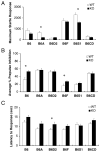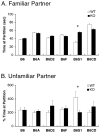Modifying behavioral phenotypes in Fmr1KO mice: genetic background differences reveal autistic-like responses
- PMID: 21268289
- PMCID: PMC3059810
- DOI: 10.1002/aur.168
Modifying behavioral phenotypes in Fmr1KO mice: genetic background differences reveal autistic-like responses
Abstract
Fragile X syndrome (FXS) is the most common inherited form of intellectual disability in humans. In addition to cognitive impairment, patients may exhibit hyperactivity, attention deficits, social difficulties and anxiety, and autistic-like behaviors. The degree to which patients display these behaviors varies considerably and is influenced by family history, suggesting that genetic modifiers play a role in the expression of behaviors in FXS. Several studies have examined behavior in a mouse model of FXS in which the Fmr1 gene has been ablated. Most of those studies were done in Fmr1 knockout mice on a pure C57BL/6 or FVB strain background. To gain a better understanding of the effects of genetic background on behaviors resulting from the loss of Fmr1 gene expression, we generated F1 hybrid lines from female Fmr1 heterozygous mice on a pure C57BL/6J background bred with male Fmr1 wild-type (WT) mice of various background strains (A/J, DBA/2J, FVB/NJ, 129S1/SvImJ and CD-1). Male Fmr1 knockout and WT littermates from each line were examined in an extensive behavioral test battery. Results clearly indicate that multiple behavioral responses are dependent on genetic background, including autistic-like traits that are present on limited genetic backgrounds. This approach has allowed us to identify improved models for different behavioral symptoms present in FXS including autistic-like traits.
Copyright © 2011, International Society for Autism Research, Wiley Periodicals, Inc.
Figures








Comment in
-
Commentary for special issue of Autism research on mouse models in ASD: a clinical perspective.Autism Res. 2011 Feb;4(1):1-4. doi: 10.1002/aur.185. Autism Res. 2011. PMID: 21328567 No abstract available.
References
-
- Abitbol M, Menini C, Delezoide AL, Rhyner T, Vekemans M, Mallet J. Nucleus basalis magnocellularis and hippocampus are the major sites of FMR-1 expression in the human fetal brain. Nature Genetics. 1993;4(2):147–153. - PubMed
-
- Ashley CT, Jr, Wilkinson KD, Reines D, Warren ST. FMR1 protein: conserved RNP family domains and selective RNA binding. Science. 1993;262(5133):563–566. - PubMed
-
- Bakker CE, Verheij C, Willemsen R, Vanderhelm R, Oerlemans F, Vermey M, et al. Fmr1 knockout mice: a model to study fragile X mental retardation. Cell. 1994;78(1):23–33. - PubMed
-
- Banbury Conference on genetic background in mice. Mutant mice and neuroscience: recommendations concerning genetic background. Neuron. 1997;19(4):755–759. - PubMed
Publication types
MeSH terms
Substances
Grants and funding
LinkOut - more resources
Full Text Sources
Other Literature Sources
Medical
Molecular Biology Databases

